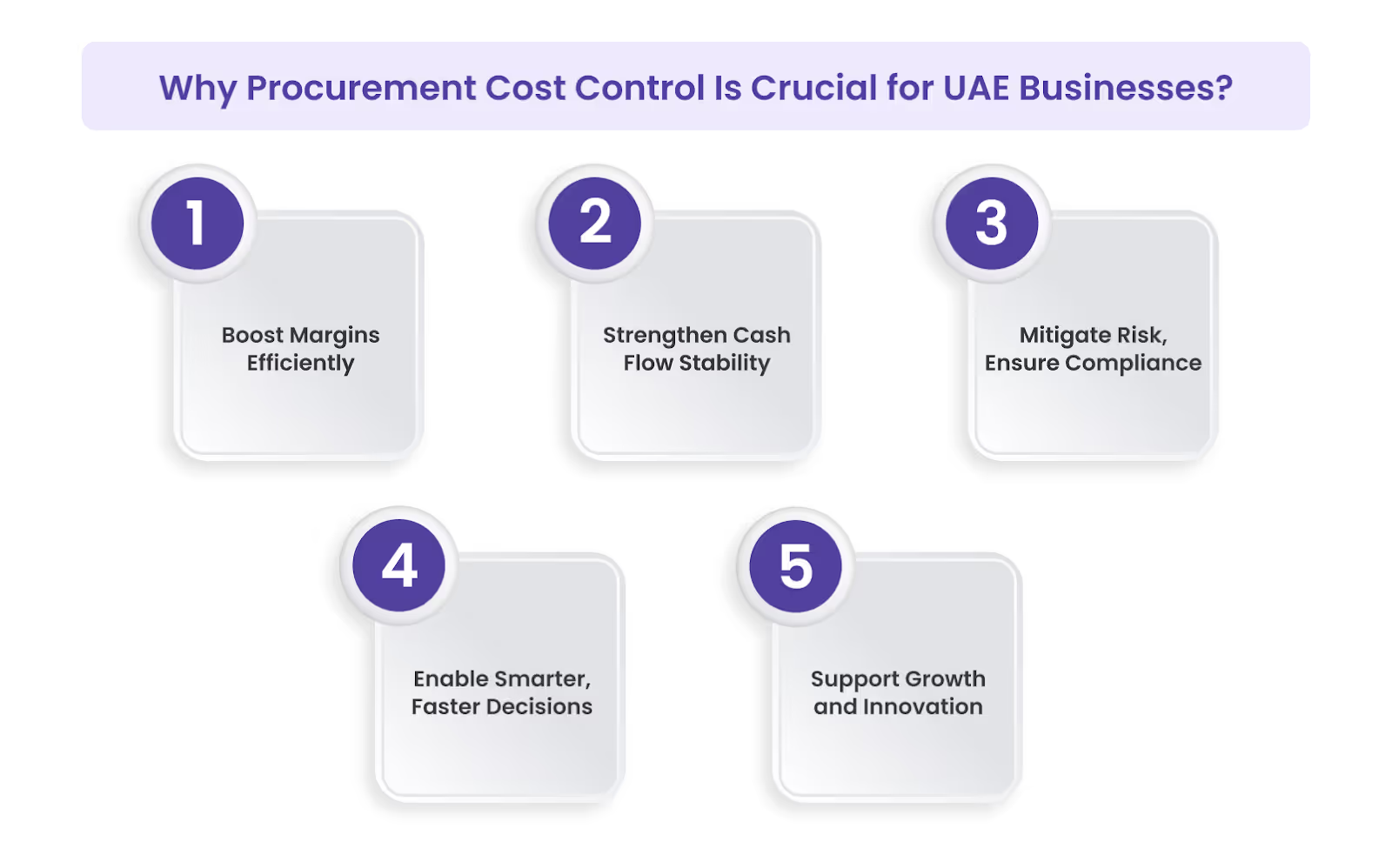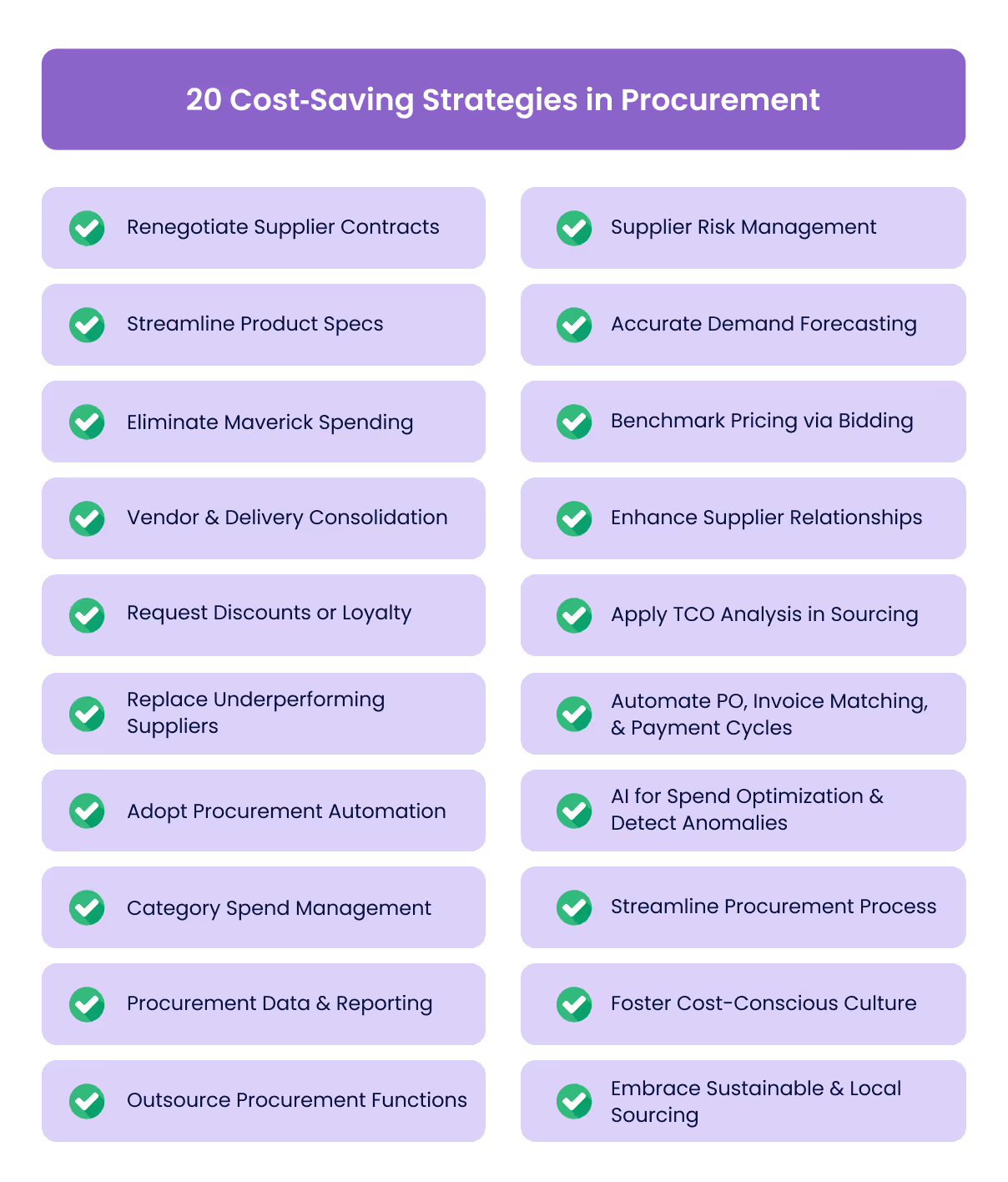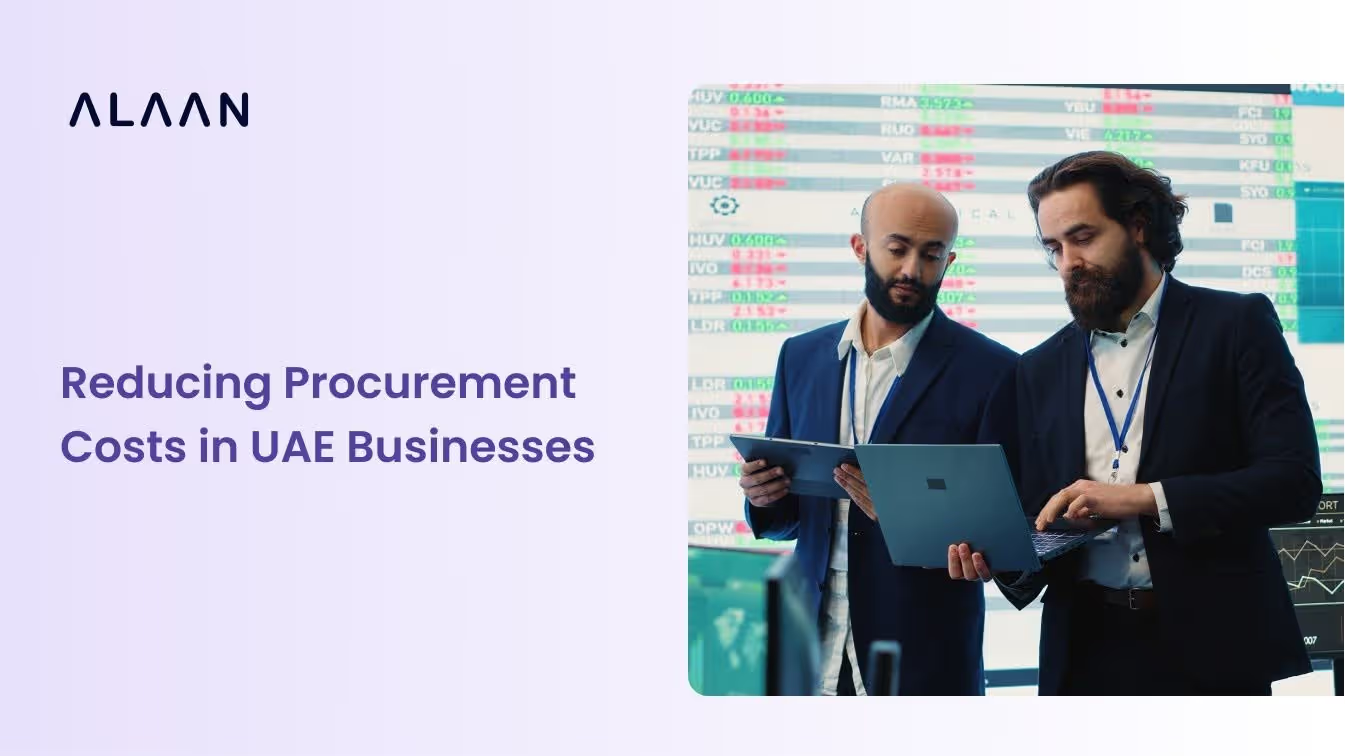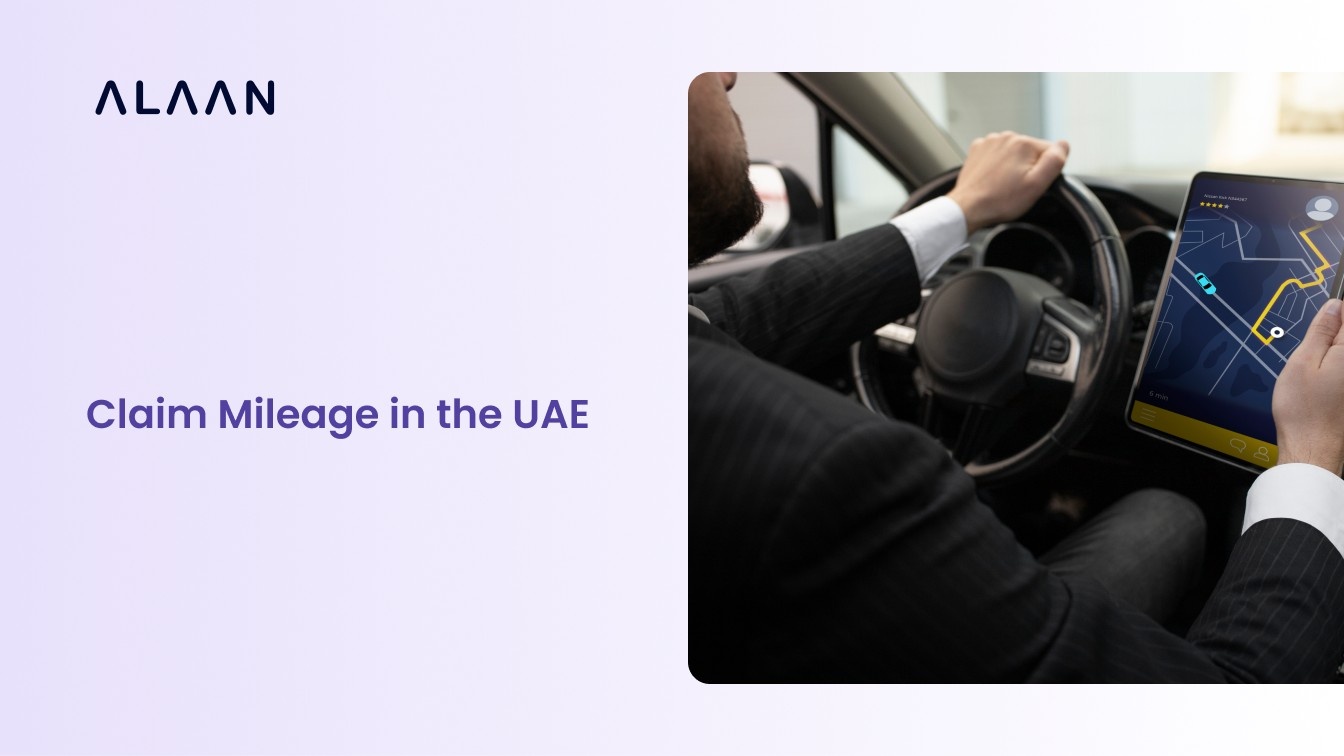Procurement in the UAE is no longer just a support function—it’s becoming one of the most powerful tools for controlling costs and driving strategic growth.
With rising inflation, complex supplier ecosystems, and increasing regulatory pressure, finance and procurement teams across the region are being asked to do more with less. In fact, the procurement-as-a-service market in the Middle East and Africa is projected to grow at 12% CAGR through 2030, with the UAE leading the charge.
To stay competitive, businesses must shift away from fragmented purchasing processes and toward smarter, tech-enabled procurement strategies.
In this blog, we explore 20 cost-saving strategies in procurement tailored for UAE businesses. From supplier consolidation to automation and AI-led spend control, these strategies can help unlock lasting value across your sourcing operations.
TL;DR: Key Takeaways
- Procurement is strategic – Done right, it drives profitability, cash flow stability, and competitive advantage in a complex market.
- Savings go beyond price – From vendor consolidation to invoice automation, cost savings are hidden across the full procurement lifecycle.
- Technology is a multiplier – AI, real-time visibility, and e-procurement tools reduce errors, speed up processes, and enforce spend controls at scale.
- Strong supplier relationships = long-term savings – Transparent communication, win-win terms, and performance tracking lead to better deals and fewer risks.
What Is Procurement and Why Does It Matter for Cost Control?
Procurement refers to the end-to-end process of acquiring goods and services that a business needs to operate. It includes supplier selection, price negotiation, purchase approvals, invoice matching, and payment processing.
In UAE-based organisations where vendor diversity, multi-currency payments, and cross-border compliance are part of daily operations, procurement is far more than a support function. It directly affects the company’s financial health and scalability.
Unstructured procurement can lead to overspending, hidden costs, and compliance gaps. A strategic approach, on the other hand, gives finance teams control over spend, improves supplier relationships, and supports long-term growth.
Why Procurement Cost Control Is Crucial for UAE Businesses?

In the UAE’s competitive and import-reliant economy, procurement directly affects business profitability, cash flow, and operational agility. Cost control in procurement isn’t just a finance function—it’s a strategic priority that impacts everything from supplier relationships to investor readiness.
Here’s why it matters:
- Improve Margins Without Growing Revenue
Every dirham saved in procurement goes straight to the bottom line. Negotiating better terms, reducing waste, and eliminating overpayments help businesses maintain healthy margins, even when revenue growth is flat or delayed.
- Strengthen Cash Flow Stability
Procurement controls allow you to manage cash timing more effectively. By aligning vendor payment cycles with receivables and budget forecasts, businesses can avoid liquidity crunches and reduce reliance on short-term borrowing.
- Ensure Compliance and Reduce Risk
With VAT, WPS, and FTA regulations to follow, procurement in the UAE must be both accurate and auditable. Automating workflows and enforcing policy controls helps prevent compliance violations and reduces exposure to penalties or disputes.
- Enable Smarter, Faster Decisions
Clear procurement data gives business leaders the visibility they need to make confident decisions—whether reallocating budgets, adjusting pricing, or negotiating new supplier contracts.
- Support Growth and Innovation
Controlling costs creates financial headroom to invest in growth initiatives, from digitisation to expansion. Strong procurement discipline also builds investor confidence and improves readiness for fundraising or strategic partnerships.
As we move forward, the companies that approach procurement with intent, data, and technology will lead in efficiency and growth.
Also Read: What is finance automation?
20 Cost‑Saving Strategies in Procurement

Controlling procurement costs demands intention and action. These 20 strategies offer powerful levers for UAE businesses to extract maximum value from every dirham spent.
Each one includes a practical explanation, bullet tips, and a concise conclusion to reinforce its impact.
1. Review and Renegotiate Supplier Contracts
Regular contract reviews are essential since market rates, supplier cost structures, and business needs evolve over time. A three-year-old agreement likely contains savings potential.
- Benchmark current pricing and payment terms using local market indices.
- Renegotiate to include early-payment discounts or volume-based rebates.
- Introduce service-level agreements (SLAs) reflecting the current UAE business pace.
Frequent contract reviews ensure your agreements stay competitive and aligned with current needs.
2. Simplify Product Specifications to Cut Unnecessary Costs
Default specifications from suppliers may include unnecessary features that inflate costs. By questioning requirements, UAE companies can simplify and save.
- Redefine needs based on real usage rather than premium offers.
- Standardise specs across departments to reduce variation.
- Open specifications to alternate suppliers by using outcome-focused criteria.
Tighter specs support competition and lower procurement costs without compromising performance.
3. Eliminate Maverick (Off-Policy) Spending
Unauthorised procurement adds inconsistency, overspending, and compliance risks. Stopping maverick spending strengthens governance and budgets.
- Use spend analytics tools to flag off-contract purchases.
- Automate approval checks tied to corporate card and vendor policies.
- Run training on approved supplier lists and escalation procedures.
Controlling rogue spend dramatically improves cost discipline and audit readiness.
4. Consolidate Vendors and Delivery Channels
Fragmented vendor bases weaken negotiating power and increase logistical complexity. Consolidation improves cost and efficiency.
- Group purchases to secure bulk discounts and reduce shipping costs.
- Limit vendor count and focus on high-performance, reliable partners.
- Centralise deliveries across UAE offices or locations to reduce freight.
Vendor consolidation boosts economies of scale and simplifies procurement operations.
5. Request Volume or Loyalty Discounts
Suppliers value long-term, stable customers, yet many organisations neglect to ask for discounts. A simple request can unlock savings.
- Discuss early-payment terms or loyalty rebates tied to UAE fiscal cycles.
- Offer forecasting visibility to suppliers as a bargaining tool.
- Structure contracts with incentives for off-peak pricing.
Proactive engagement uncovers hidden savings and strengthens supplier partnerships.
6. Identify and Replace Underperforming Suppliers
Undertaking regular supplier reviews uncovers poor-performing or overpriced vendors, then pivoting spending accordingly saves significantly.
- Benchmark all suppliers' rates annually against market intelligence.
- Phase out or renegotiate with those who are lagging in quality or cost.
- Reward high-performing suppliers with longer contracts or volume increases.
Strategic supplier management enhances value and prevents cost leakage.
7. Adopt Procurement Automation Tools
Manual purchase-to-pay systems are slow, error-prone, and costly. Modern tools streamline operations and uncover new areas of efficiency.
- Implement e-procurement to automate approvals, ordering, and invoicing processes.
- Use AI-powered spend analytics to find cost trends and anomalies.
- Use tools that integrate with VAT-compliant UAE accounting systems.
Digital procurement platforms reduce errors and empower smarter sourcing decisions.
8. Implement Category-Based Spend Management
Treating categories such as IT, logistics, and facilities separately enables better control and sourcing strategies.
- Appoint responsible owners for each major spend category.
- Track category performance via KPIs, including price, quality, and delivery reliability.
- Align category plans with UAE business events such as Expo cycles.
Focused category management leads to improved leverage and targeted savings.
9. Centralised Procurement Data and Reporting
Scattered data hides insights and impedes decision-making. Centralised systems bring clarity and strategic advantage.
- Integrate P2P, ERP, and spend analytics into a unified database.
- Use dashboards to visualise spend by department, vendor, and project.
- Maintain a central supplier repository with performance and contact data.
Data centralisation transforms procurement from a reactive to a proactive approach.
10. Outsource Non-Core Procurement Functions
Outsourcing indirect spend categories lets internal teams focus on strategic priorities and reduces overhead.
- Consider outsourcing logistics, facilities, or security procurement.
- Select regional providers with operational capabilities in the UAE.
- Shift internal resources to high-impact tasks like tender management.
Outsourcing frees internal capacity and often achieves better pricing.
11. Assess and Mitigate Supplier and Contract Risks
Risk in procurement impacts both cost and operational integrity, especially in volatile supply chains.
- Identify single-source dependencies and develop backup options to mitigate potential risks.
- Negotiate risk-sharing clauses in supplier contracts, such as those related to currency fluctuations.
- Monitor vendor risk factors, including compliance and financial stability, to ensure a secure and reliable supply chain.
Risk-aware procurement protects savings and minimises disruptions.
12. Forecast Demand Accurately and Control Inventory
Accurate demand forecasting prevents both excess stock (which is costly) and stockouts (resulting in lost revenue).
- Use historical and real-time data for predictive planning.
- Automate reorder thresholds based on demand patterns.
- Implement JIT and ABC analysis to balance stock and costs.
Smarter forecasting and inventory practices help preserve cash and prevent waste.
13. Use Competitive Bidding to Benchmark Pricing
Bringing multiple vendors into a structured competition delivers better pricing and quality.
- Use reverse auctions or sealed tender processes.
- Develop evaluation frameworks that consider the total cost, not just the price.
- Include both local UAE suppliers and global suppliers to offer a balanced selection.
Competition drives better deals and ensures suppliers stay accountable.
14. Strengthen Supplier Partnerships for Long-Term Value
Collaborative partnerships deliver more value, resulting in joint innovation, flexible terms, and shared goals.
- Schedule quarterly business reviews to explore joint savings opportunities.
- Share forecasts and align priorities, especially in peak seasons (e.g. Ramadan).
- Encourage supplier innovation in packaging, logistics, or product design.
Strong supplier ties enhance performance and unlock co-created savings.
15. Apply Total Cost of Ownership (TCO) Analysis in Sourcing
Viewing only the upfront price misses hidden lifecycle costs in sourcing decisions.
- Include maintenance, transport, disposal, and training costs in the calculation.
- Compare alternatives across lifecycle cost, not just sticker price.
- Reassess TCO annually to account for market and regulatory changes.
TCO-based sourcing avoids hidden charges and supports smarter long-term investment.
16. Automate PO, Invoice Matching, and Payment Cycles
Invoice errors and manual corrections can be costly in terms of time and money. Automation can solve both issues.
- Match PO, receipt, and invoice automatically to catch discrepancies early.
- Negotiate early-payment discounts via electronic systems.
- Reduce paper handling and administrative errors.
Automation accelerates processing, cuts costs, and improves data accuracy.
17. Leverage AI to Optimise Spend and Detect Anomalies
AI can uncover complex patterns, predict risks, and expedite decisions, all while reducing costs.
- Use AI for anomaly detection and trend analysis across large datasets.
- Automate contract review and risk scoring to flag vendor issues.
- Predict optimal purchase times and anticipate price movements.
AI delivers results-oriented savings, freeing your team to focus on strategic tasks.
18. Promote Lean Procurement Practices
Lean methodologies strip out wasted effort and simplify workflows.
- Map current processes and identify where steps add no value.
- Apply continuous improvement cycles to eliminate redundancies and streamline processes.
- Engage suppliers in lean logistics and shared efficiency goals.
Lean methods make procurement faster, more cost-effective, and more efficient.
19. Create a Cost-Conscious Culture Across Teams
Savings only stick when people support them. It is important to remember that training and culture play a crucial role.
- Provide regular training on tools, flags, and approved processes.
- Share success stories to reinforce savings behaviour.
- Empower staff to suggest improvements and reward cost-saving ideas.
A savings-focused culture makes procurement everyone’s responsibility.
20. Embrace Sustainable & Local Sourcing
Buying regional and eco-conscious isn’t just ethical; it often costs less when done right.
- Prioritise UAE-based vendors to reduce freight, tariffs, and currency risk.
- Switch to energy-efficient equipment or minimal eco-packaging.
- Integrate sustainability metrics into procurement KPIs.
Local, sustainable sourcing supports ESG goals while reducing hidden costs.
These 20 strategies, ranging from contract renegotiation to AI automation, offer a comprehensive playbook for UAE enterprises. When combined, they improve fiscal discipline, supply chain resilience, and operational efficiency. This holistic framework turns procurement from a cost centre into a strategic engine of business growth.
Also Read: Backlog Accounting in UAE: Key Insights and Advantages
Why UAE Procurement Teams Use Alaan to Control Costs?
Managing vendor payments, approvals, and expense tracking across departments is no easy task, especially when every dirham counts. That’s why UAE businesses trust Alaan.
Alaan is an AI-powered spend management platform that simplifies procurement by giving finance teams full visibility and control. With smart corporate cards, automated approvals, and real-time expense tracking, you can manage procurement spend without chasing paperwork or reconciling spreadsheets.
Here’s how Alaan helps procurement leaders gain control:
- Smart Corporate Cards with Built-In Spend Rules: Instantly issue virtual or physical cards to procurement staff, project heads, or department leads. Set merchant restrictions, category-level budgets, and daily or monthly spend limits. Whether you’re buying office equipment or vendor services, every payment is pre-approved and policy-compliant.
- Real-Time Expense Visibility and Alerts: Track every procurement transaction as it happens. Alaan’s live dashboard gives finance teams immediate insight into what’s being spent, by whom, and with which supplier, no more waiting until month-end to spot budget leaks.
- Custom Approval Flows That Match Your Procurement Hierarchy: Create approval workflows based on purchase type or amount. Set single-click approvals for low-ticket items and multi-level routing for large vendor contracts. Every expense follows your company’s procurement policy by default.
- AI-Powered Receipt Matching and VAT Compliance: Procurement staff can upload receipts, and Alaan automatically extracts VAT details, including TRN, invoice number, amount, and flags any issues for review. This ensures all vendor payments are claim-ready and audit-compliant with UAE VAT regulations.
- Direct Integration with Accounting and ERP Systems: Connect Alaan to your existing accounting software like Xero, NetSuite, or Microsoft Dynamics. All procurement expenses are auto-categorised and synced in real time, so you can reconcile books faster and minimise manual entry errors.
Whether you manage purchasing for a retail chain, logistics provider, or enterprise in the UAE, Alaan helps you reduce procurement friction, prevent overspending, and enforce controls without slowing your teams down.
Join 1,000+ companies across the UAE using Alaan to simplify procurement and take control of business spending.
Final Thoughts
Procurement is a strategic lever for UAE businesses seeking growth, resilience, and financial clarity. In a market shaped by global supply chain shifts, fluctuating input costs, and evolving VAT requirements, every dirham saved through smarter procurement adds directly to your bottom line.
The 20 cost-saving strategies outlined in this blog offer a blueprint for transforming procurement into a value-generating function. From digitising spend to optimising supplier partnerships, each action contributes to better margins, reduced risk, and a more agile organisation.
But strategy needs execution, and Alaan can help you with that.
Alaan helps UAE finance and procurement teams move from manual oversight to intelligent automation, issuing smart corporate cards, enforcing policies in real-time, and syncing expenses directly with your accounting systems. It’s built for businesses that want to take control of procurement without adding complexity.
Book your free demo with Alaan today and power smarter procurement from Day One.
FAQs
Q. What is the difference between cost savings and cost avoidance in procurement?
A. Cost savings refer to tangible reductions in current spending, like negotiating a lower supplier rate. Cost avoidance, on the other hand, prevents future expenses by locking in fixed pricing to avoid inflation or automating workflows to reduce future headcount requirements.
Q. How can SMEs in the UAE adopt these strategies without a large procurement team?
A. Smaller businesses can still apply many of these strategies by starting with spend analysis, consolidating vendors, and digitising approvals using tools like Alaan. Automation levels the playing field by reducing the need for large teams to manage complex processes.
Q. What KPIs should procurement teams track to measure cost-saving impact?
A. Key performance indicators include cost savings as a percentage of spend, purchase order cycle time, contract compliance rate, supplier performance scorecards, and the volume of off-contract spend. These help track both financial and operational efficiency.
Q. How can procurement teams ensure cost savings don’t impact supplier relationships?
A. Cost reduction doesn’t have to mean aggressive negotiation. UAE companies can maintain strong supplier relationships by proposing win-win solutions, such as long-term contracts, volume commitments, or expedited payments, in exchange for improved terms.
Q. How often should procurement strategies be reviewed or updated?
A. Ideally, procurement strategies should be reviewed annually or whenever there are major business changes, such as expansion, new regulatory requirements, or significant supplier shifts. A quarterly spend review helps ensure ongoing alignment with goals.


.avif)







%201.avif)